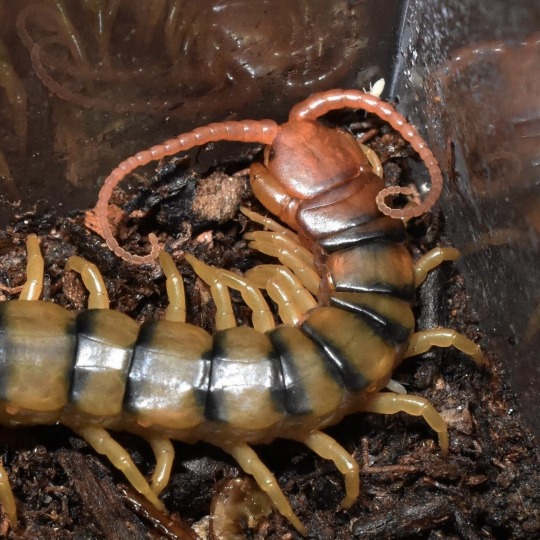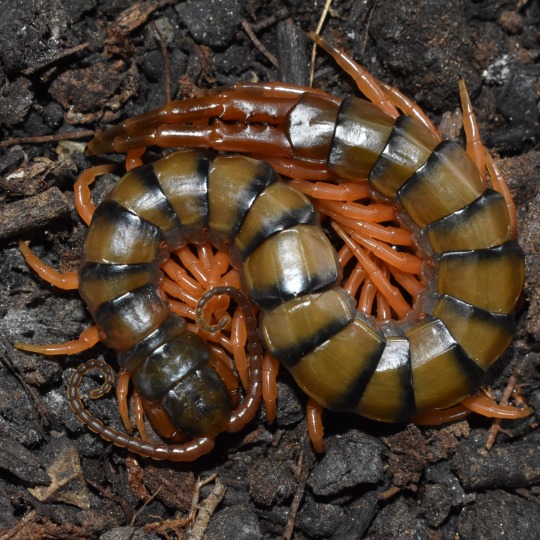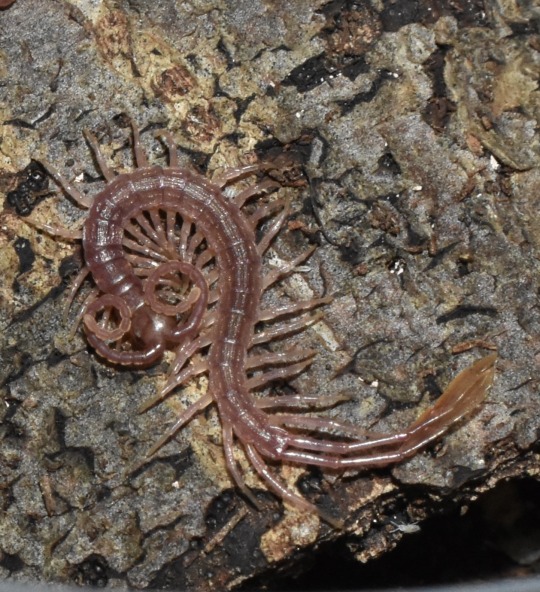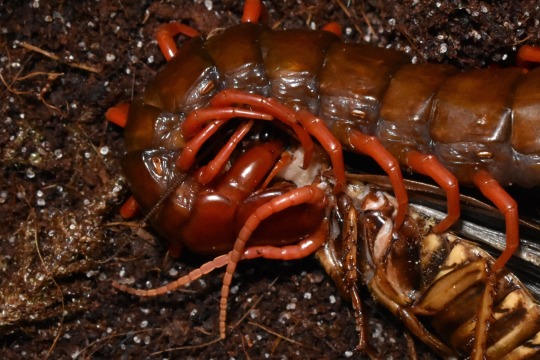#scolopendra polymorpha
Explore tagged Tumblr posts
Text
handsome sunstorm tucking in to some chicken dinnar
1K notes
·
View notes
Text

drawing per day: 26/31
11 notes
·
View notes
Text

Spent a good chunk of time on this thing, and I'm not the happiest with how the shading turned out in the end, but it works for its purpose.
It is supposed to be a Common Desert Centipede, but I'm not completely sure how well I conveyed that considering it's in black and white.
Once I have more time (and money...), I'll get around at looking for a good tattoo artist in my area.
(I do so much centipede-related art. I think I might have a bias)
#centipede#centipede art#Scolopendra polymorpha#arthropods#common desert centipede#clip studio paint#digital art#my art#my post#while I made this to be a tattoo for myself#I would prefer if other people did not use it without notifying me at least.
2 notes
·
View notes
Note
Thanks for agreeing to help me :^)
I work at a cave. Recently in the breakroom they found a giant sonoran desert centipede. These are EXCEEDINGLY common in our area. Our boss regularly sprays human buildings with insecticide to keep kids from getting hurt (mostly at the risk of bark scorpions) and my coworkers decided to keep this enormous kitchen centipede and now he is our mascot. His name is real dalton. Problem is i dont know a goddamn thing about centipedes or how to care for one. Its kinda on me to make sure his enclosure is okay cuz i know my coworkers arent gonna give it as much thought as i will (despite honestly not really wanting a centipede. but i like milipedes. and i unfortunately am amazing friends w my coworkers. so like a bunch of kids asking to keep a feral racoon, i, father, said yes) and im wondering what it needs. Do these critters need enrichment???? What are the dos and donts?
i’m assuming you mean scolopendra heros - these are notoriously almost impossible to keep in captivity for long periods of time because they are extremely prone to mycosis (mold growing inside of them that kills them) I would probably release it. but if you do decide to keep it, you need to keep it in a VERY well ventilated container with a locking lid. a mixture of sand and dirt is fine for substrate. you can feed them bugs like roaches or mealworms once or twice a week. a shallow water dish is important but any moisture is a risk with these guys so it is up to you. and their venom is very bad so don’t get bit!
#my friend got bit and he said it felt like his hand was getting hit with a hammer for weeks straight#scolopendra polymorpha are much easier to keep and like some humidity
4 notes
·
View notes
Text
Common Desert Centipede (Scolopendra polymorpha)
#inaturalist#naturalist#nature#ecology#zoology#biology#wildlife#bug#bugblr#entomology#bugs#invert#invertebrates#invertiblr#photography#nature photography#wildlife photography#hawks photos#animal photography#myriapod#myriapods#centipede#centipedes
818 notes
·
View notes
Note
Hello! I hope you don't mind me asking, but what does it mean when a Centipede's antenna curl? I've been really curious about it, and I tried looking it up, but I couldn't find any actual answers, and I was wondering if you knew? Again, sorry if I've bothered you, have a good day! (And thank you, if you do answer)



some centipedes curl their antennae when at rest or when they are comfortable. I notice some otostigmine centipedes like the last two (Ethmostigmus, Alipes) curl theirs more often than scolopendrines (Scolopendra polymorpha), but it’s still a common behavior.

a centipede with antennae tightly swept back usually has a prey item in its clutches and wants to keep its most crucial sensory organs away from the prey as it fights back.
360 notes
·
View notes
Note
your centipedes are so cool, ive been wondering about how to start! do you have any resources/tips?
of course! bear with me here because there's a lot to go through
if you're going all out and want to get it perfect, you need: a plastic tub with a locking lid (ideally), a drill for making ventilation holes, tongs for feeding/maintenance, a water bowl, peat or topsoil, sand, gravel, and some bark for hides and decoration.
-- SPECIES --
"beginner" species: scolopendra polymorpha (#1 recommendation), scolopendra cingulata, scolopendra morsitans & ethmostigmus trigonpododus. these guys are relatively inexpensive, usually pretty docile, easy to care for, easy to find & have milder venom than the larger species! however, you can obviously keep any species you want and it's your choice. just do plenty of research first. as cute as they are, many of the other species are extremely venomous and lightning-fast and deserve respect. it won't help either of you if you buy a pede that terrifies you to care for. ):
⚠︎ venom ⚠︎: several scolopendra species are extremely venomous, including subspinipes, sp. malaysian tiger, and dehaani. and you do decide to go for one of the spicier land dragons you need to fully understand the responsibility it entails. an escaped centipede can harm not just you, but your other pets and family members. you need to be sure you can handle the risk not just to yourself but others. please thoroughly research bite reports of the species you're looking for before buying so you know what you're getting in to. <3 also invest in some tongs for general maintenance. don't go putting your hands in willy nilly or you get the bitey witey ....
-- SETUP --
enclosure: expect a true escape artist. centipedes cannot climb smooth surfaces like glass or plastic but they CAN push themselves up against the surface to their fully stretched body length and if they can reach the lid it's game over. they can also grip on to ventilation holes and push off of enclosure decor. you would need a plastic enclosure that is taller than your pede and substrate combined. i currently use these tubs for my larger pedes as they have locking lids with very small gaps around the edges.

above are my setups for astraeus and choso! they have ventilation around all sides. i also have velcro straps securing the lids as double protection just because I got paranoid when I first put them in their new enclosures, but now I keep them on anyway because I feel better that way sbdhnfjm
ventilation: cross-ventilation is ESSENTIAL. there's a lot of misinfo online about this. a centipede needs ample ventilation at the bottom of their enclosure on all sides to prevent stagnant air and gas buildup so you would need to drill a few rows of ventilation holes. also make sure they're not big enough for a smaller pede to squeeze out of, because they can and will if they can fit!
⚠︎ MYCOSIS ⚠︎ is a thing. it's essentially a fungal infection that centipedes can get in damp, stagnant conditions, and it starts out as black spots typically on the legs and antennae. keeping a pede too wet with little or no ventilation just spells out disaster. don't be tempted to over-spray a pede's enclosure. if a pede does get mycosis, it can molt of out it if its enclosure is allowed to dry out more.
HOWEVER! the more ventilation you add and the less you spray, the higher the risk of desiccation (drying out). this is where it gets a little tricky. there needs to be a balance between the setup being too wet and too dry. best way to combat this is to keep one side damp and the other dry whilst providing a water dish. this way the pede can choose if it wants to be damp or dry.

above is astraeus modelling the substrate in their enclosure. they have a mix of sedge peat, desert sand, and gravel. they're leaned up against their fav piece of cork bark here too, where they spend the entire day before coming out at night.
substrate: this depends on the species you pick, but most pedes do well on a mixture of peat/topsoil and sand. mix gravel in as well as they like to move it around. the internet says to use coco fiber. DON'T!!!! pedes ingest some substrate when they eat their food and the fibers from coco coir will cause impaction and death.
-- DIET --

food: live prey includes gut-loaded crickets, locusts, superworms, and roaches. centipedes reach their maximum sizes most often when fed a varied diet. you can include raw meats (no fat!), shrimp, low-copper cat food and even fruits from time to time. most pedes aren't too picky and will eat whatever they can get their forcipules in to :P akaza above eating a prawn for tax/proof!
centipedes are opportunistic. they can eat large prey items and then go a long time without eating. every week is fine for an adult.
be sure to remove uneaten food to prevent the build up of gases and bacteria. springtails in the enclosure can help to minimize waste that is missed.
i think that covers it. maybe. i hope ASDFG
TOO LONG DIDN'T READ VERSION:
mix of peat/topsoil and sand
no coco fiber.
one side damp one side dry
water dish
wood for hides/decoration
tongs for feeding/maintenance
varied diet
cross-ventilation
most importantly, have fun. <3
(p.s. big thank you to the people of the chipotle centipede server for all their help and info as well, without them I wouldn't know half of this.)
#asks#centipede#centipedes#<3#hope this helps sorry for the wall of text T-T#if you happen to keep old world tarantulas and you think it'll be like that. it's not#i've kept so many OW Ts and i went into centipedes thinking itd be similar but oh nooooo#centipedes are so much faster. lightning speed.#astraeus rivals my wandering spiders and huntsmans in speed.
13 notes
·
View notes
Note
I've got an interesting idea for a bug race for a one piece au! Since there is Fishmen and Minks with many distinct animal and fish features in their appearance so how about a race with insect, arachnid and other invertebrate features! 🐌🦋🐛🐜🐝🪲🐞🦗🪳🕷️🕸️🦂🦟🪰🪱 And what kind of bug would each straw hat member be in this AU?
Okay so fun fact about me, I was an entomology major in college before I dropped out. So thank you for this request because it was very self indulgent!
Insect AU
Luffy would be a jack jumper ant (Myrmecia Pilosula). This ant is very strong even by ant standards. Like their name suggests, they can leap up to 76 millimeters, which is extremely impressive when you take into account that they range from 11 - 14 millimeters in size. On top of that, they possess a potent venom that kills other insects with ease. They are notably aggressive, even towards things much larger than themselves, and can reliably kill prey much larger than themselves. Truly a fierce fighter that can go toe to toe with many enemies.
Zoro would be a centipede, specifically the Scolopendra Polymorpha. This centipede varies a lot in color, and can even be green. These guys pack some pretty serious venom with necrotic properties, not something you want to experience. Centipedes are extremely agile predators that can take down all kinds of prey with ease thanks to their strength and ability to contort their body.
Nami would be a velvet ant (Dasymutilla Occidentalis). Despite the name, these guys are not ants, but are ground dwelling wasps that happen to resemble ants. They have a deceptively cute reddish-orange fuzzy appearance, that makes their venomous sting all the more surprising. While only males of the species can fly, females have a stinger that delivers a devastating venom to whatever has it on the defense. While the effects of it are excruciating, it is not fatal.
Usopp would be a spiny leaf insect (Extatosoma Tiaratum). Despite the name, males don’t have many spikes beyond the ones on their face and some defensive ones on the legs, but they can fly so at least they have that going for them. One of their means of defense is to do a threat pose that makes them resemble a scorpion (and the nymphs mimic the appearance of a toxic species of ants), which sounds like a very Usopp thing to do in my humble opinion.
Sanji would be a budwing mantis (Parasphendale Affinis). This is widely considered to be the most aggressive mantid species. I will preface this by saying that this mostly applies to females, but for the sake of the AU, I’m going to ignore that and allow Sanji to have these qualities. The budwing mantis is a voracious predator that regularly kills prey three times the size of themselves, and will do their damnedest to intimidate even bigger animals. These guys are ambush predators with insanely fast reflexes. Males are especially eager to find a mate (however fatal that may be).
Chopper is a bumblebee, specifically the Bombus Balteatus. Why did I choose that one, you ask? Because it was the fluffiest looking one I could find. As for the rest of the reasoning, Chopper just has cute bumblebee vibes to me. He likes using his honey in his medicine when applicable. This is another case of us ignoring insect gender-roles.
Robin is a noble false widow spider (Steatoda Nobilis). This spider is commonly mistaken for black widows even though I don’t get how because they look nothing alike I mean really it’s like saying wolf spiders look like a brown recluse, so they have an unfairly bad reputation. While their venom is medically significant, it’s on par with a bee sting and nothing to worry about.
Franky is an atlas beetle (Chalcosoma Atlas). These are massive beetles with a very tough shell and most notably, have three long horns both for defense and mating purposes. Despite their intimidating size, they are actually quite friendly and make for great pets.
Brook would be a prairie mole cricket (Gryllotalpa Major). Despite the name, these aren’t true crickets, just a close relative. Lacking the specialized legs that crickets use to chirp, they instead rub their wings together to make noise. They dig burrows specifically designed to have excellent acoustics so as to help more females hear their “music”, which is surprisingly complex and can have up to five harmonics.
Jinbei would be a lobster. Not really an insect, but a relative of them no less.
#one piece#monkey d luffy#zoro roronoa#luffy#nami#cat burglar nami#one piece nami#usopp#sanji#black leg sanji#tony tony chopper#nico robin#franky the cyborg#cyborg franky#brook#soul king brook#jinbei#insect au
55 notes
·
View notes
Text

Invertober Day 29: Tiger Centipede (Scolopendra polymorpha)
Reference by Seth Patterson
[Image ID: A digital painting of a Tiger Centipede, only its face, three of its body segments, some of its legs, and most of its antennae are visible. Its antennae are curled inward. It is coming into the piece from the top left corner. It uses the colors red, pink, purple, and blue, all of which are very saturated. It is on an alternating purple background. End ID.]
#I said I was gonna finish invertober and I goddamn meant it#also i know the reference is a different scolopendra species shhhhhh its ok all scolopendra shape wise look extremely similar#bug#bugblr#bug art#bugs#centipede#centipedes#myriapoda#my art#art#invertober2023#invertober
27 notes
·
View notes
Note
Spade leaned in close and if listen enough you might hear a mechanical wirl as he arm moves, "show me your pets, please? What are their names? Which one is your feistiest? which one's your sweetest?" The question spilling from him as felt excited to learn more about his new friend.
-♠️ (Spade)
Roach's eyes lit up like a damn Christmas tree. He scrambled off, quickly returning with a few small plastic containers.
"This is Zipper," he said, showing Spade the centipede that twisted in his palm. "She's a Scolopendra polymorpha. Most people are scared of her, so I guess she's my fiercest."
He placed the centipede down on his thigh and opened a container. Whatever was in it hissed as he reached his hand inside.
"These are Madagascar hissing cockroaches. Wanna hold one?"
#((im so happy for roach))#((lil guy gets to infodump about his bugs for the first time ever))#cod ask#bug answers#cod rp#cod ask blog#gary roach sanderson rp#ask blog#♠️ anon
3 notes
·
View notes
Text
luxurious raw salmon offering to the sand beast (sunstorm, scolopendra polymorpha) 🏜
63 notes
·
View notes
Text
Invertober 2023!
Invertober is back! The (mandatory) drawing challenge where you draw an invertebrate every day. It's for everyone and *mandatory.* Last year they had no ants on the list! I was very upset... this year there is one ant... an improvement, still so much more room to grow!
Let's shoot for 10 ants next year.
OK here is what you need to draw each day for the month:
Sunburst diving beetle (Themanectus marmoratus)
Silvery leaf cutter bee (Megachile leachella)
Little fire ant (Wasmannia auropunctata)
Emerald green snail (Papustyla pulcherrima)
Citrus root weevil (Diaprepes abbreviatus)
Coconut octopus (Amphioctopus marginatus)
Common banded hover fly (Syrphus ribesii)
Calico Crab (Hepatus epheliticus)
Elephant hawk moth (Deilephila elpenor)
Periodical cicada (Magicicada septendecim)
Fruit fly (Drosophila melanogaster)
Eelgrass isopod (Pentidotea resecata)
Devastating grasshopper (Melanoplus devastator)
Blue glaucus (Glaucus atlanticus)
Owlfly (Libelloides macaronius)
Fuchsia flatworm (Pseudoceros ferrugineus)
Blue morpho (Morpho peleides)
Reddish-brown stag beetle (Lucanus capreolus)
White-spotted jellyfish (Phyllorhiza punctata)
European mantis (Mantis religiosa)
Pink crab spider (Thomisus onustus)
Red velvet ant (Dasymutilla occidentalis)
Asian forest scorpion (Heterometrus spinifer)
African monarch (Danaus chrysippus)
Horned sea star (Protoreaster nodosus)
Torpedo bug (Siphanta acuta)
Iceland scallop (Chlamys islandica)
Striped pajama squid (Sepioloidea lineolata)
Tiger centipede (Scolopendra polymorpha)
Leopard slug (Limax maximus)
Halloween pennant (Celithemis eponina)

Let's goooo!
#invertober#invertober2023#drawing#drawings#ants#bugs#bugblr#invertebrates#antblr#drawing ants#artists on tumblr#drawing challange#mandatory#for everyone
11 notes
·
View notes
Text

Invertober Day 28- Tiger Centipede (Scolopendra polymorpha)
Process video under the cut (in the form of a youtube short because for some reason tumblr wont let me upload the file directly >:[ !!!!! )
These damn legs are gonna be the death of me. never drawing somethign with this many legs AGAIN!!!!!!!!!
#invertober#invertober 2023#fossilforager invertober#centipede#tiger centipede#digital art#speedpaint#speed draw#artists on tumblr#ghostiezone#stuck-in-the-ghost-zone
6 notes
·
View notes
Text
Nature Hikes Early 2025 - Part 1
Okay so I have been posting a lot to my Bluesky lately and keep forgetting to post here. So I'm going to compile some of my photos from various nature hikes I've taken lately.
Let's start with stuff I've spotted just walking around my neighborhood.











Okay! First two photos are of a webspinner. I saw a pair of them wandering the sidewalk during an especially windy day before a storm. That same day I also found what I think is a rove beetle (next photo) and also a ladybug larva which accepted the invitation to walk on my hand but then tried to digest my finger (he chewed on me a while and barfed on my finger).
The next pair of photos are field crickets I've seen at night lately, very pretty. And the next pair of photos is some sort of jet-black, smooth grub that felt like crushed velvet. I think it's a Soldier Beetle larva, seems to match it best. Then there is some kind of soil centipede, very long and skinny. Next is an example of the frogs that live around here in great numbers, but I especially liked this one because of the reddish color on his back which others have lacked. The frog is probably a Pacific chorus frog (Pseudacris regilla).
I also want to share the huge millipedes that live in the field by the neighborhood that come out at night. I took one home to photograph it in better light and then returned it to its home.



They are SO sweet and cute. I love them to bits. There are a number of giant millipede species, but I currently favor the Tylobolus genus as most likely here.
I also spotted a bunch of giant centipedes on the sidewalk a few nights ago:

It's a still from a video, so looks a bit wonky, sorry. Most likely this badboy is Scolopendra polymorpha. This species has a lot of color morph variants depending on where it's from. This one is from California and is called the California Blue-Leg Tiger Centipede. They are native. They are also intensely speedy and intimidating. I thought I'd never get a clean shot of him but he suddenly stopped for about 15 seconds, twitching its antenna, before starting up again, and gave me the chance to see it properly. I made sure to not get too close, you don't want to go grabbing a centipede.
Next up are some photos from a local park not too far from me that I visit a lot.















There are many very large rocks on this piece of land. Some have neat holes worn into them. The rainwater fills them up sometimes. These rocks have weird lichens as well. The sixth image is a bizarre brown lichen I found growing on a rock. There are plenty of lichens and moss growing on wood as well, of course.
The flowers are Red Maids (Calandrinia ciliata), Blue Dicks (Dichelostemma capitatum), Popcorn Flowers (Plagiobothrys) and Miner's Lettuce (Claytonia perfoliata).
And already I've hit the post limit for photos. I'll need to do a second part for the rest of the images.
#image heavy#nature hikes#my nature hikes#insects#bugs#amphibians#frogs#myriapods#millipedes#centipedes#lichens#moss#fungi#flowers#mycontent
0 notes
Text
ive decided im finally gonna get a dream pet i have always wanted. i want a scolopendra polymorpha (desert tiger centipede) i have plans this week and dont wanna over spend but next paycheck ill order the enclosure then see who looks reputable to order from/check in with a local reptile and critter shop i know of to see if they have any of them in stock. not a lot of shops i trust tho so i think ill need to order, which is difficult bc ill need to be home to sign for the baby and i work a lot </3
0 notes
Text
Found a baby centipede in a tub, im gonna try and keep it as a pet. Looks to be Scolopendra polymorpha, so I might be able to influence its colors as it grows by giving it a specific environment to camouflage against. Catch some flies from the bucket compost and we're good to go for now!
0 notes